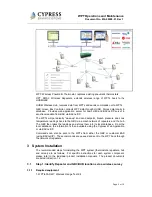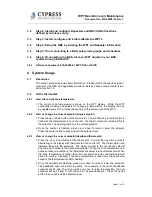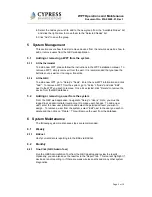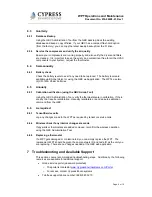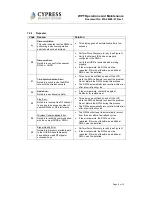
WPT Operations and Maintenance
Document No. 910-00028-01, Rev 1
Page 2 of 10
WPT: Wireless Pneumatic Thermostat, replaces existing pneumatic thermostats
RPT, RWAL: Wireless Repeaters, extends wireless range of WPTs back to the
HUSB/GBC
HUSB: Wireless Hub, receives data from WPTs and sends commands out to WPTs
GBC: Green Box Controller, collects WPT data through HUSB. Stores data locally in
database. Provides web application server for basic HMI and BACnet/IP server to
send/receive data from BAS via BACnet/IP.
The WPTs will periodically “wake-up” and send setpoint, branch pressure and zone
temperature readings back to the GBC via a mesh network of repeaters and the hub.
The GBC then takes the readings and stores them into its local database. From the
local database, the information is then available using the Cypress Web Application
or via BACnet/IP.
Commands can also be sent to the WPTs from either the GBC or customer BAS
(using BACnet/IP). These commands are queued and sent to the WPT back through
the network of repeaters.
3 System Installation
The recommended steps for installing the WPT system (thermostats, repeaters, hub
and server) are as follows. For specific instructions for each system component,
please refer to the individual product installation manuals. The product documents
are listed in Section 1.2.
3.1
Step 1: Identify Repeater and GBC/HUB locations via a wireless survey
3.1.1 Required equipment:
1. WPT-800-RKIT: Wireless Range Test Kit


